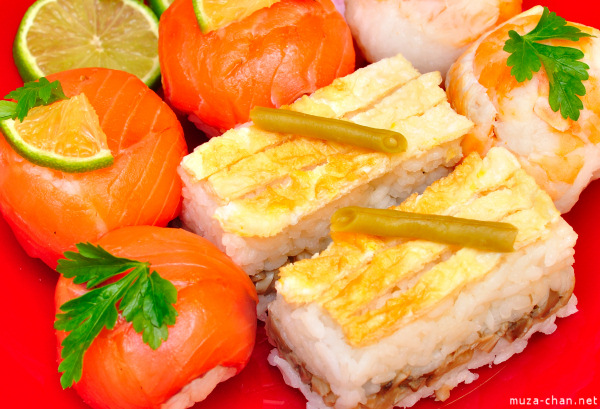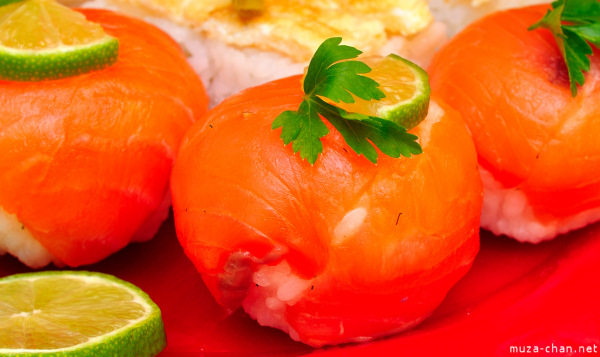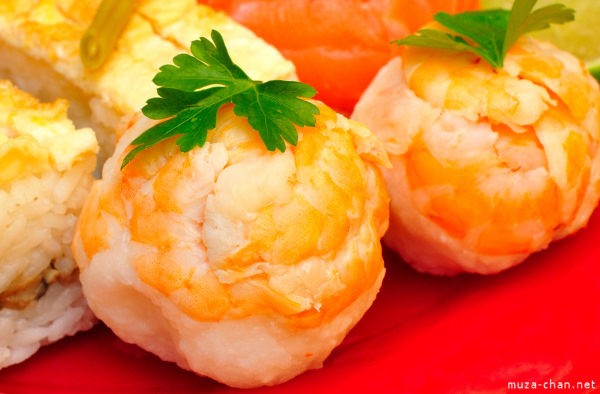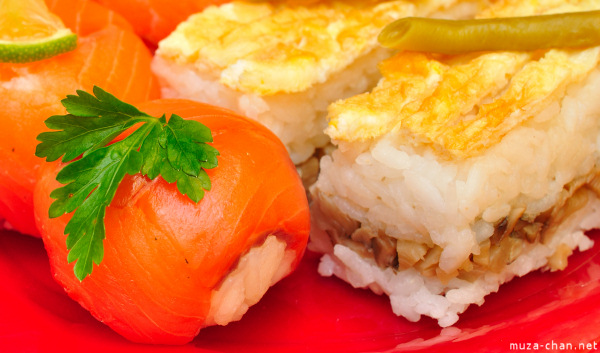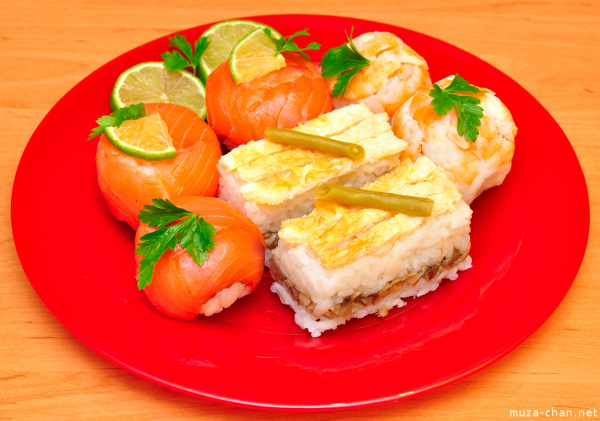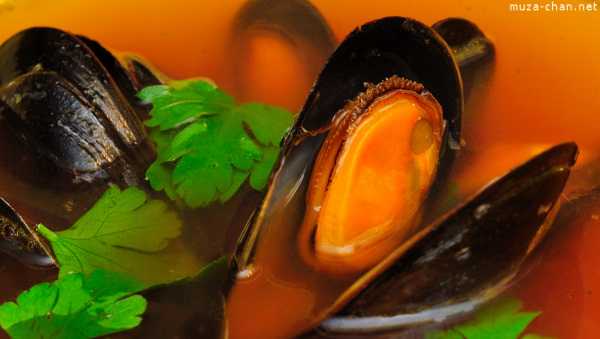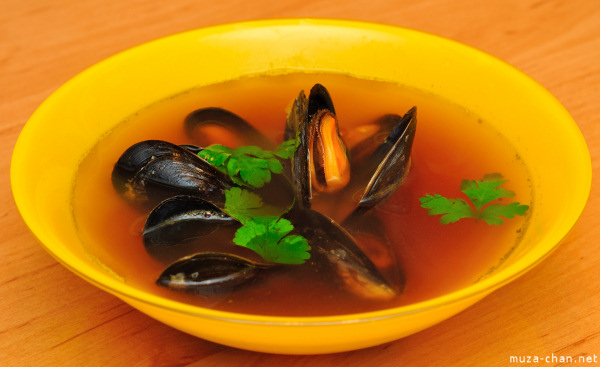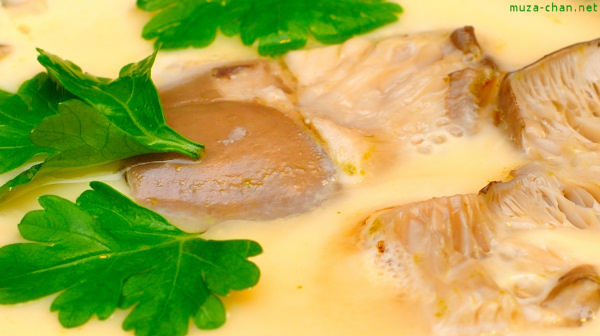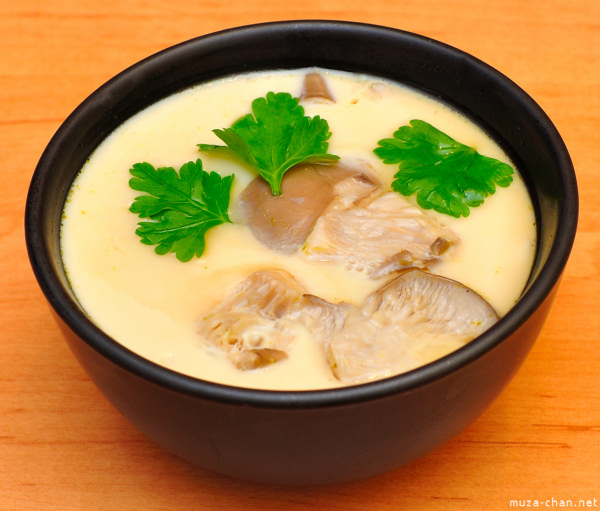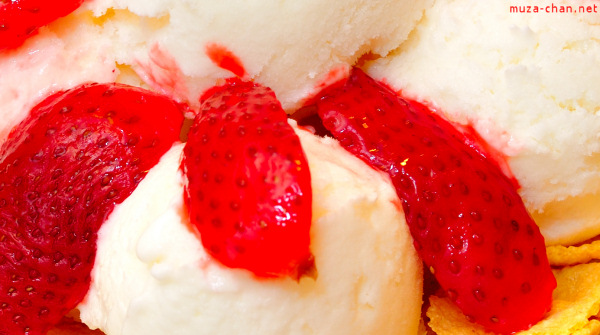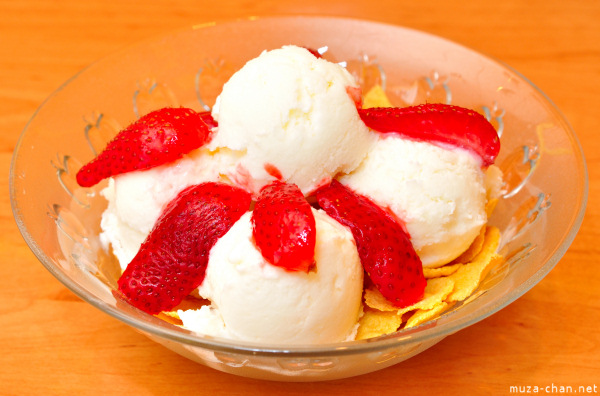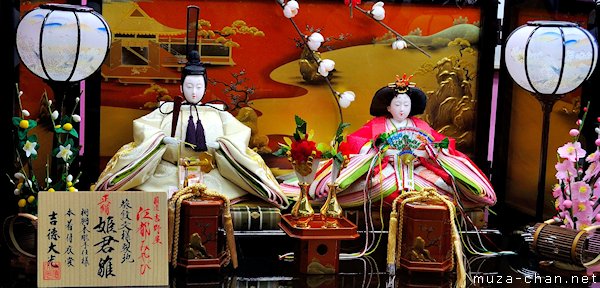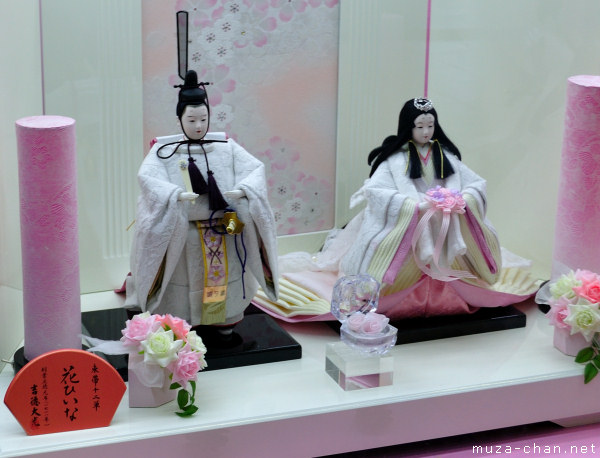On March 3rd, Japan celebrates Hina Matsuri 「雛祭り」, the Japanese Doll Festival, also known as the “Girl’s Day", an important event, especially for families with daughters.
Click on photo for higher resolution:
The Hina matsuri originates from an ancient Chinese tradition: Through a magical rite, the evil spirits were transfered into a doll that was placed on a boat and cast away on a river.
The custom was initially known in Japan as the Hina nagashi 「雛流し」 - floating dolls. Let’s watch a recording from the Shimogamo Shrine in Kyoto:
At the beginning of the Edo period, a new custom appeared, to display inside the house a set of dolls dressed in Heian period clothing.
The full set of Hina Matsuri dolls (hina-ningyo) consists in 15 dolls, the most important being the Emperor (Odairi-sama) and the Empress (Ohina-sama), placed on the uppermost step of the stand…
Click on photo for higher resolution:
Pe 3 martie, în Japonia are loc Hina Matsuri 「雛祭り」, sărbătoarea păpuşilor, cunoscută şi cu denumirea de “ziua fetelor", un eveniment important, mai ales pentru familiile cu fete.
Click on photo for higher resolution:
Hina matsuri îşi are originea într-un vechi obicei chinezesc. Printr-un ritual magic, spiritele rele şi ghinionul erau transferate într-o păpuşă, care era apoi pusă într-o barcă şi i se dădea drumul pe o apă curgătoare.
Obiceiul a fost preluat în Japonia, unde s-a numit iniţial Hina nagashi 「雛流し」, păpuşi plutitoare. Iată o înregistrare de la altarul Shimogamo din Kyoto:
La începutul perioadei Edo a apărut un obicei nou, acela de a expune în casă un set de păpuşi îmbrăcate în haine din perioada Heian.
Setul complet de păpuşi (hina-ningyo) este format din 15 păpuşi, dintre care cele mai importante sunt Împăratul (Odairi-sama) şi Împărăteasa (Ohina-sama), aşezate pe treapta cea mai de sus a suportului…
Click on photo for higher resolution:
… followed by three court ladies (sannin-kanjo), five musicians (gonin-bayashi), two ministers (udaijin and sadaijin), three servants and many accessories (furniture, tableware, sakura tree, etc.)
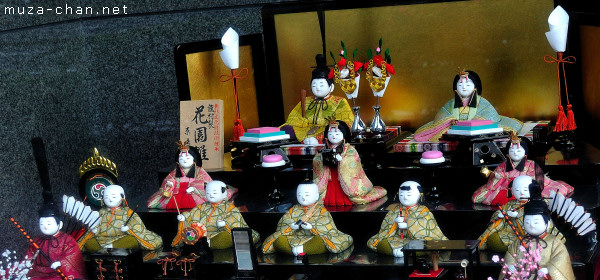 Hina Matsuri Dolls
Hina Matsuri DollsOf course, there are some popular superstitions, probably the most interesting is that the family must not forget to disassemble the set immediately after the festival, otherwise their daughters will marry very late… or not at all. :)
Here’s also a song dedicated to this festival, Ureshii Hina Matsuri:
The custom is also well represented in the old ukiyo-e paintings. A good example is Nishikawa Sukenobu’s painting The Doll Ceremony
 Nishikawa Sukenobu - The Doll Ceremony Image via: Wikipedia
Nishikawa Sukenobu - The Doll Ceremony Image via: Wikipedia
Of course, references to Hina Matsuri cannot be missing from the pop culture, so there are even sets of anime-related Hina Matsuri dolls, like these Lucky Star characters: ;)
At this celebration, a special fine foods menu is prepared. The recipes varies from one region to another. I was able to cook this delicious Hina Matsuri menu, thanks to the recipes from Nishinomiya, gracefully provided by Simona:
- Temari sushi and Oshi sushi
- Hamaguri no shiojiru
- Chawan mushi
- Ichigo parfait
The meal was a big culinary success and it’s fairly easy to cook, so I think anyone with interest in cooking will appreciate it.
1. Temari sushi and Oshi sushi
Sushi rice ingredients:
- 300g sushi rice
- 4 tablespoons rice vinegar
- 2 tablespoons sugar
- 1 teaspoon salt
Rinse the rice, discard the water using a colander and leave it for 30 minutes. Cook the rice with slightly less water than usual (rice and water in equal quantities). When the rice is cooked, pour the mixture of rice vinegar, sugar and salt over the rice while cooling it with a paper fan. Be careful not to mush the rice. You will use half of the rice for Temari sushi and the other half for Oshi sushi.
Temari sushi
Ingredients:
- 40g filets of tuna sashimi
- 4 pieces of octopus
- 4 shrimps
- ingredients for marinade: 4 tablespoons sake, 4 tablespoons soy sauce and 4 tablespoons dashi/soup stock
- ingredients for topping: 1 oba leaf, lime, wasabi paste, sweet pickled ginger, mitsuba leafs
Cut the fish into thin, wide slices. Bring the marinade sauce to a boil and then let it cool. Soak the fish into the sauce for 30 minutes.
Cut the octopus into thin slices.
Stick a toothpick into the belly side of the shrimp, to keep the shrimp stretched. Bring water to a boil, add a pinch of salt and cook the shrimp for 1 minute. Drain and let the shrimp cool. Remove the shell and the toothpick and cut into thin slices.
On a piece of plastic wrap, place one slice of tuna and some sushi rice. Pull up the ends of the wrap and squeeze firmly to give a spherical shape (the name temari sushi comes from “te", which means “hand” and “mari” which means “ball").
Repeat, replacing the tuna slices with the octopus and shrimp slices.
Add the topping before serving.
Oshi sushi
Ingredients (for two portions):
- 6 small dried shiitake mushrooms (100ml of water used to re-hydrate the mushrooms)
- 1 tablespoon sugar
- 1 tablespoon soy sauce
- 4 snow peas
- 1 egg and vegetable oil (for omelette)
Beat the egg, add a pinch of salt and make omelette, as thin as possible. Cut the omelette into thin strings.
Mince finely the re-hydrated mushrooms. Cook them with 100ml of water, 1 tablespoon sugar and 1 tablespoon soy sauce. Cook down until the water mixture disappears.
Make a mold using a milk carton box and wet inside the mold with vinegar and water. Use half of the rice by placing a quarter inside the mold, then place half of the mushrooms, and then another quarter of rice. Compress it to fill the mold.
Push the sushi out of the mold, place the omelette strings on the top of the sushi and cut in half. Repeat with the remaining rice and mushrooms, for the second portion.
Place the snow peas on the top before serve.
Note:
Due to Romanian market availability, I replaced tuna with salmon and mitsuba with parsley. Its not same taste, so I strongly recommend mitsuba, if you can find it. :)
2. Hamaguri no shiojiru
Ingredients:
- 8 clams(hamaguri)
- kelp (6cm square) for dashi
- 2 tablespoons sake
- 1 tablespoon soy sauce
- salt
- mitsuba leafs
Soak the clams in water with salt. Scrub them clean under cold running water.
Put the clams and 3 cups of dashi into a saucepan and bring to a boil over medium heat, until clams open.
Remove from fire, extract the clams and place them in two bowls. Strain the soup through a fine sieve. Add sake, soy sauce and salt and reheat.
Garnish with the mitsuba leafs before serving.
Soup is customary in Romanian menus, so this was the most appreciated part of this menu. :)
3. Chawan mushi
Ingredients:
- 50g chicken thighs
- 1/2 teaspoons soy sauce
- 1/2 teaspoons sake
- 2 big shiitake mushrooms
- 8 mitsuba leafs
- 4 slices of steam fish
Ingredients for the egg mixture:
- 2 eggs
- 2 dashi cups
- 1/4 teaspoon salt
- 2 teaspoons soy sauce
Remove skin and fat from the chicken thighs and cut into small pieces. Mix with soy sauce and sake. Re-hydrate the mushrooms, cut and discard the stems. Slice the mushrooms cup into quarters.
Put the ingredients for the egg mixture except the eggs into a saucepan. Bring it to a boil and let it cool. Break the eggs into a bowl and stir gently. Add the ingredients and mix well. Strain the egg mixture through fine sieve to make it smooth.
Divide the ingredients into 4 cups and poor the egg mixture, leaving 1cm space between the mixture and the top of the cup. Place the cups in a bamboo steamer. Use a wet cloth as a cover. Cook it in high heat for 2 minutes. Reduce the heat and continue to cook for 15 minutes. Insert a toothpick into the egg mixture and if it comes out clear, the mixture is ready to serve.
Place the mitsuba leaf on top.
4. Ichigo parfait (strawberry parfait)
Ingredients:
- 100g strawberry
- 1.5 tablespoon sugar
- vanilla ice cream
- cornflakes
Discard the stems and cut the strawberries into quarters.
Put the strawberries into a heat resistant bowl and coat them with sugar. Let it stand for 5 minutes. Microwave without cover for 3 minutes. Let it cool and chill it on the fridge.
Put the cornflakes and the ice cream into a glass. Put the strawberries on top.
Enjoy!
… apoi urmează trei doamne de la curte (sannin-kanjo), cinci muzicieni (gonin-bayashi), doi miniştri (udaijin şi sadaijin), trei servitori şi multe accesorii (piese de mobilier, veselă, un mandarin, un sakura etc.)
 Hina Matsuri Dolls
Hina Matsuri DollsO superstiţie populară atenţionează familia să nu uite să strângă setul de păpuşi imediat după sărbătoare. Dacă vor neglija acest lucru, fetele din acea casă se vor mărita târziu… sau deloc. :)
Iată şi un cântec dedicat sărbătorii, Ureshii Hina Matsuri:
Obiceiul îl găsim reprezentat şi în arta veche, în picturile ukiyo-e. Am ales spre exemplificare pictura lui Nishikawa Sukenobu intitulată The Doll Ceremony
 Nishikawa Sukenobu - The Doll Ceremony Image via: Wikipedia
Nishikawa Sukenobu - The Doll Ceremony Image via: Wikipedia
Referinţe la Hina Matsuri se găsesc şi în anime-uri şi au apărut şi figurine cu personaje anime, ca acest set cu personaje din Lucky Star: ;)
Cu ocazia acestei sărbători se serveşte un meniu special, care diferă de la o regiune la alta. Eu am avut ocazia să gătesc un meniu tradiţional din oraşul Nishinomiya (reţete primite de la Simona (Hanami) :
Meniu Hina Matsuri
- Temari sushi and Oshi sushi
- Hamaguri no shiojiru
- Chawan mushi
- Ichigo parfait
1. Temari sushi şi Oshi sushi
Ingrediente pentru orez:
- 300g orez de sushi
- 4 linguri de oţet de orez
- 2 linguri de zahăr
- o linguriţă de sare
Se spală orezul, se strecoară şi se lasă 30 de minute. Se fierbe cu o cantitate de apă puţin mai mică decât de obicei (o măsură de orez la o măsură de apă ). După ce s-a fiert, se toarnă amestecul de oţet de orez, zahăr şi sare şi se amestecă încet, având grijă să nu se zdrobească boabele. În timp ce se amestecă, se răceşte cu un evantai de hârtie. Se împarte orezul în două părţi egale, o parte se va folosi la Temari sushi, iar cealaltă la Oshi sushi.
Temari sushi
Ingrediente:
- 40g file de ton pentru sashimi
- 4 bucăţi de caracatiţă
- 4 creveţi proaspeţi
- pentru marinat: 4 linguri sake, 4 linguri de sos de soia şi 4 linguri dashi/supă
- pentru garnitură: o frunză de oba, felii de lămaie verde, pastă de wasabi, ghimbir murat, mitsuba
Se taie peştele în felii subţiri. Se amestecă ingredientele pentru marinat şi se pun la foc mic, până începe să fiarbă. Se ia de pe foc şi se lasă la rece. Se toarnă peste bucăţile de peşte şi se lasă la marinat 30 minute.
Se taie caracatiţa în felii subţiri. Se înfige o scobitoare pe lungimea crevetelui, pentru a nu se încovoia (dacă creveţii sunt pre-fierţi, sunt deja încovoiaţi). Se pun creveţii în apă fiartă, cu puţină sare şi se lasă la fiert un minut. După ce s-au răcit se curăţă cochilia. Se taie în felii lungi foarte subţiri.
Denumirea temari sushi vine de la “te” care înseamnă mână şi “mari” care înseamnă bile. Pe o folie de plastic se pune o felie de ton, apoi un rând de orez şi se împachetează sub forma unei bile. La fel se procedează înlocuind tonul cu felii de caracatiţă şi creveţi.
Se serveşte cu garnitură.
Oshi sushi
Ingrediente:
- 6 ciuperci shiitake mici
- 1 lingură de zahăr
- 1 lingură sos de soia
- 4 păstăi fasole verde
- un ou
- ulei vegetal pentru omletă
Se bate un ou cu puţin zahăr şi puţină sare şi se face o omletă foarte subţire. Se taie omleta în felii subţiri.
Se toacă mărunt ciupercile, apoi se pun la fiert la foc mic, împreună cu 100 ml apă, zahărul şi sosul de soia. Se lasă la fiert până ce se evaporă toată apa.
Se pune un sfert din cantitatea de orez într-o formă de hârtie făcută dintr-o cutie de lapte, umezită cu un amestec de mirin şi apă. Se pune deasupra jumătate din cantitatea de ciuperci, apoi încă un rând de orez. Se presează uşor ca să se aşeze bine orezul. Se scoate din formă şi se taie pe jumătate. Se aranjează deasupra fâşiile de omletă şi o păstaie de fasole verde.
Notă:
Am înlocuit tonul cu somon, mitsuba cu pătrunjel, iar ciupercile shiitake cu bureţi de fag.
2. Hamaguri no shiojiru
Ingrediente:
- 8 scoici (hamaguri)
- o bucată kelp (un pătrat de 6 cm) pentru dashi
- 2 linguri sake
- o lingură sos de soia
- sare
- câteva frunze de mitsuba
Se pun scoicile în apă cu puţină sare şi se lasă 10-15 minute. Se freacă bine fiecare scoică în parte sub un jet de apă rece. Se toarnă într-o oală 3 căni de dashi şi scoicile şi se pune la fiert pe foc mediu. Se lasă să fiarbă câteva minute până ce scoicile se deschid.
Se ia de pe foc, se scot scoicile şi se pun în două boluri. Se strecoară supa printr-o strecurătoare fină. Se adaugă sake, sosul de soia şi sarea şi se pune din nou pe foc, până începe să fiarbă. Se toarnă supa fierbinte peste scoici şi se serveşte caldă, cu mitsuba tocată presărată deasupra.
Notă:
Pentru că în Romania nu se găsesc anumite ingrediente, se poate înlocui kelp-ul cu concentrat de legume şi mitsuba cu pătrunjel.
3. Chawan mushi
Ingrediente:
- 50g piept de pui dezosat
- 1/2 linguriţă sos de soia
- 1/2 linguriţă sake
- 2 ciuperci mari shiitake
- 8 frunze mitsuba
- 4 felii subţiri de peşte fiert la aburi
Ingrediente pentru crema de ou:
- 2 ouă
- 2 căni de dashi
- 1/4 linguriţă sare
- 2 linguriţe sos de soia
Se înlătură grăsimea şi pielea de pe pieptul de pui şi se taie carnea în cubuleţe mici. Se toarnă 1/2 linguriţă sos de soia şi 1/2 linguriţă sake peste carnea de pui şi se lasă 10 de minute la marinat. Se spală ciupercile, se păstrează doar pălăriile, care se taie în patru.
Se pun la fiert pe foc mic 2 căni de dashi, 1/4 linguriţă sare şi 2 linguriţe sos de soia şi se lasă până începe să fiarbă. Se ia vasul de pe foc şi se lasă să se răcească. Se bat uşor cele două ouă, fără să facă spumă. Se adaugă supa de mai sus şi se amestecă bine. Se bate bine cu un mixer până se omogenizează. Se curăţă cu o spatulă eventualele porţiuni de spumă sau se strecoară printr-o sită fină.
Se împart în patru părţi egale carnea de pui, ciupercile şi peştele şi se pun în patru ceşti. Se toarnă crema de ou, având grijă să nu fie umplute până sus. Se acoperă cu o bucată de pânză udă şi se pun la aburi puternici timp de 2 minute. Se reduce temperatura şi se lasă să fiarbă la aburi 15-20 de minute. Se verifică cu o scobitoare dacă este gata. Se serveşte cu garnitură de mitsuba.
Notă:
Se poate înlocui dashi cu apă, mitsuba cu pătrunjel şi ciupercile shiitake cu bureţi de fag.
4. Ichigo parfait (parfait de căpşuni)
Ingrediente:
- 100g căpşuni
- 1,5 linguri de zahăr
- îngheţată de vanilie
- cornflakes
Se taie căpşunii în 4 bucăţi, pe lungime, se acoperă cu zahăr şi se lasă 5 minute. Se pun în cuptorul cu microunde timp de 3 minute, se lasă apoi să se răcească, iar după aceea se pun în frigider.
Se aşează un strat de cornflakes pe fundul bolului, deasupra se pune îngheţata de vanilie şi se ornează cu căpşuni.
Poftă bună!



